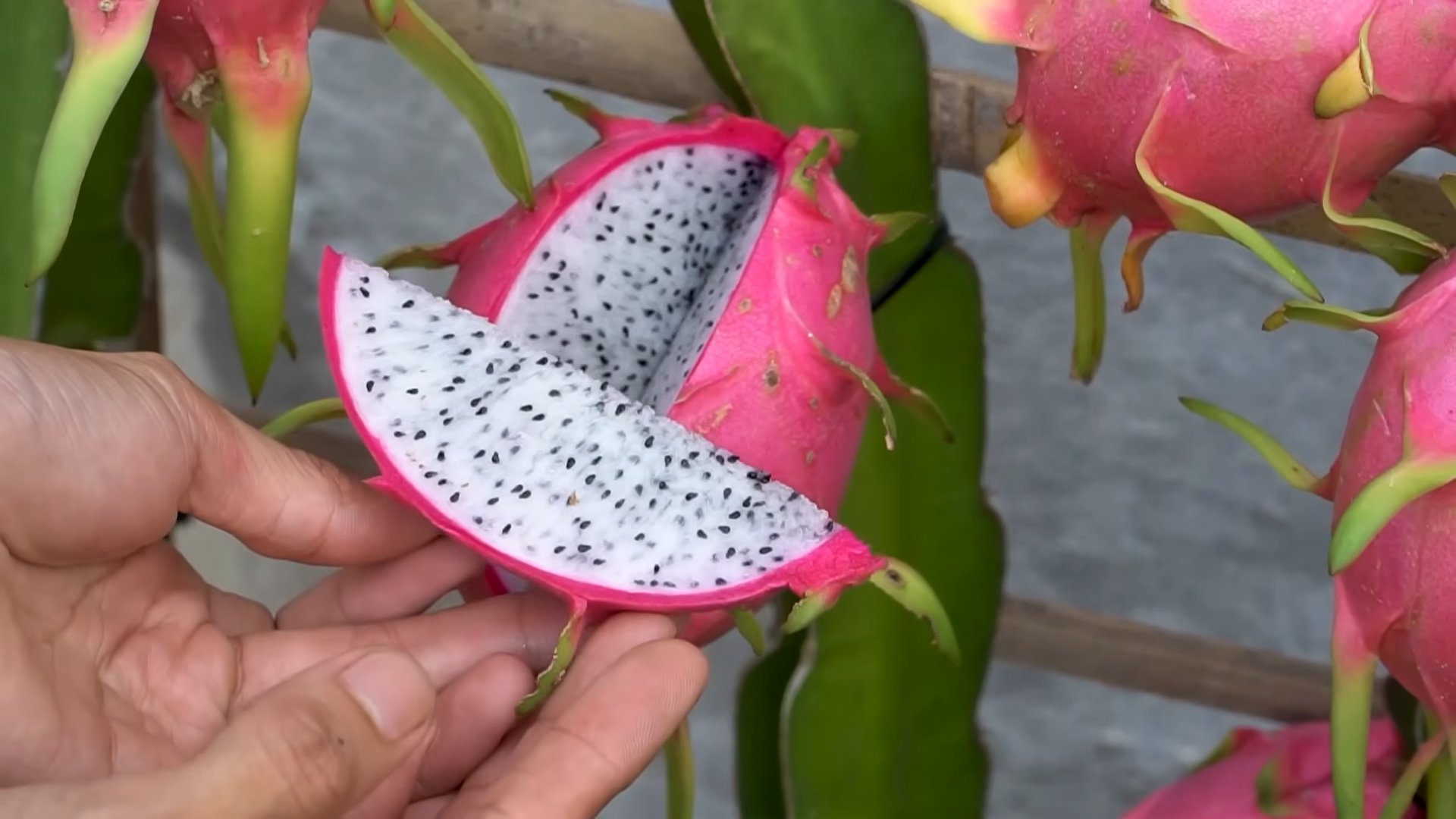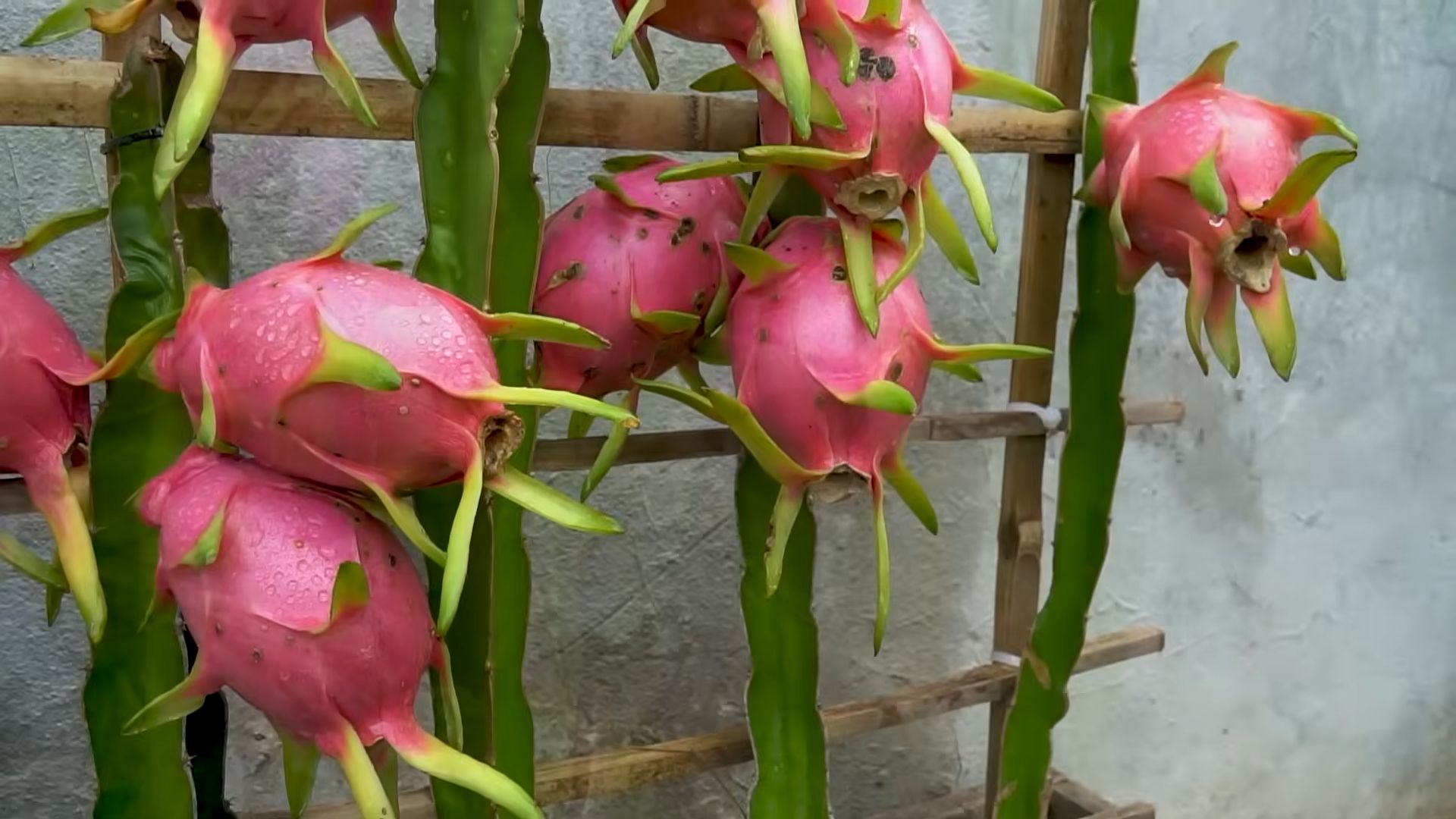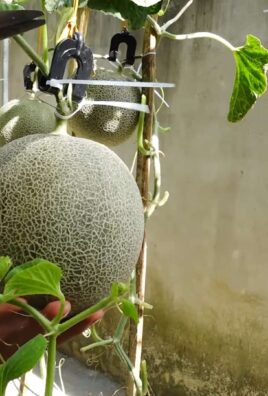Grow Dragon Fruit at Home? Absolutely! Imagine plucking a vibrant, exotic dragon fruit straight from your own backyard. Sounds like a tropical dream, right? Well, it’s more attainable than you think! For centuries, dragon fruit, also known as pitaya, has been cherished in Southeast Asia and Latin America, not just for its unique flavor and stunning appearance, but also for its impressive health benefits. Now, you can bring a touch of the tropics to your own home with these simple DIY tricks.
I know what you’re thinking: “Dragon fruit? Isn’t that difficult to grow?” That’s where this guide comes in! Many people shy away from the idea of growing exotic fruits, assuming it requires a greenhouse or specialized knowledge. But I’m here to tell you that with a few clever hacks and a little patience, you can successfully grow dragon fruit at home, even if you’re a beginner gardener. This DIY guide will break down the process into easy-to-follow steps, covering everything from choosing the right variety to providing the perfect support system for your climbing cactus.
Why should you embark on this exciting gardening adventure? Beyond the satisfaction of harvesting your own delicious fruit, growing dragon fruit at home is a sustainable and rewarding way to add a touch of the extraordinary to your life. Plus, you’ll have a conversation starter that’s sure to impress your friends and neighbors! So, grab your gardening gloves, and let’s get started!

Growing Dragon Fruit at Home: A Comprehensive DIY Guide
Hey there, fellow plant enthusiasts! Ever dreamt of having your own exotic dragon fruit hanging right in your backyard (or even indoors)? Well, dream no more! Growing dragon fruit at home is totally achievable, and I’m here to guide you through every step of the process. It might seem intimidating at first, but trust me, with a little patience and the right know-how, you’ll be enjoying your own homegrown dragon fruit in no time.
Choosing the Right Dragon Fruit Variety
Before we dive into the nitty-gritty, let’s talk about varieties. Not all dragon fruit are created equal, and some are better suited for home growing than others.
* Self-pollinating vs. Non-self-pollinating: This is crucial! Some varieties need cross-pollination (meaning you need two different varieties to get fruit), while others are self-pollinating. For beginners, I highly recommend sticking with self-pollinating varieties.
* Popular Self-Pollinating Varieties:
* ‘Haley’s Comet’: A reliable and popular choice, known for its pink skin and white flesh.
* ‘Physical Graffiti’: Another excellent self-pollinating option with vibrant pink flesh.
* ‘American Beauty’: This variety boasts a beautiful pink skin and magenta flesh.
* Taste and Texture: Consider your personal preferences. Some varieties are sweeter, while others have a slightly tart flavor. The texture can also vary from crisp to juicy. Do a little research to find a variety that appeals to your taste buds.
* Climate Considerations: Dragon fruit thrives in warm climates (USDA zones 9-11). If you live in a cooler region, you can still grow dragon fruit in containers and bring them indoors during the winter.
Getting Started: Propagation Options
You have a few options for starting your dragon fruit journey: seeds, cuttings, or purchasing a young plant. I personally prefer cuttings because they’re faster and more reliable.
* Seeds: Growing from seed is possible, but it takes longer (several years to fruit) and the resulting plant may not be true to the parent variety.
* Cuttings: This is my preferred method! Cuttings root easily and will produce fruit much sooner than seedlings. You can often find cuttings at local nurseries or online.
* Young Plants: If you want to skip the propagation stage altogether, you can purchase a young dragon fruit plant from a nursery.
Step-by-Step Guide: Propagating Dragon Fruit from Cuttings
Let’s get our hands dirty! Here’s how to propagate dragon fruit from cuttings:
1. Obtain a Healthy Cutting: Look for a cutting that’s at least 12 inches long and about 1-2 inches in diameter. The cutting should be healthy, green, and free from any signs of disease or pests. Make sure the cut end is clean and straight.
2. Callus the Cutting: This is an important step! Allow the cut end of the cutting to dry and callus over for about 7-10 days. This helps prevent rot when you plant it. Place the cutting in a dry, shaded area. You’ll notice the cut end forming a hardened layer.
3. Prepare the Potting Mix: Dragon fruit needs well-draining soil. I recommend a mix of cactus potting mix, perlite, and a little bit of compost. This combination provides good drainage and nutrients.
4. Plant the Cutting: Fill a pot (at least 6 inches in diameter) with the prepared potting mix. Make a hole in the center and insert the calloused end of the cutting about 2-3 inches deep.
5. Water Sparingly: Water the cutting lightly after planting. Avoid overwatering, as this can lead to rot. The soil should be moist but not soggy.
6. Provide Support: Dragon fruit is a climbing cactus, so it needs support from the very beginning. Insert a stake or small trellis into the pot next to the cutting.
7. Place in a Warm, Bright Location: Dragon fruit needs plenty of sunlight to thrive. Place the pot in a warm, sunny location that receives at least 6 hours of direct sunlight per day. If you’re growing indoors, a south-facing window is ideal.
8. Be Patient: It can take several weeks or even months for the cutting to root. Keep the soil consistently moist (but not soggy) and be patient. You’ll know the cutting has rooted when you see new growth emerging.
Planting and Caring for Your Dragon Fruit
Once your cutting has rooted and started to grow, it’s time to transplant it into a larger pot or directly into the ground (if you live in a suitable climate).
1. Choosing the Right Location: Dragon fruit needs a sunny location with well-draining soil. If you’re planting in the ground, choose a spot that receives at least 6 hours of direct sunlight per day.
2. Preparing the Soil: Dragon fruit prefers slightly acidic soil with a pH of 6.0-7.0. Amend the soil with compost and other organic matter to improve drainage and fertility.
3. Transplanting: Carefully remove the dragon fruit plant from its pot and plant it in the prepared soil. Make sure the top of the root ball is level with the surrounding soil.
4. Providing Support: Dragon fruit needs a strong support structure to climb on. A sturdy trellis, post, or even a tree can be used. The support should be at least 6 feet tall.
5. Watering: Water your dragon fruit regularly, especially during the growing season. Allow the soil to dry out slightly between waterings. Avoid overwatering, as this can lead to root rot.
6. Fertilizing: Fertilize your dragon fruit every 2-3 months with a balanced fertilizer. You can also use compost or other organic fertilizers.
7. Pruning: Prune your dragon fruit regularly to encourage branching and fruit production. Remove any dead or damaged stems. You can also prune to control the size and shape of the plant.
8. Pest and Disease Control: Dragon fruit is relatively pest and disease-resistant, but it can be susceptible to certain problems. Watch out for pests like aphids, mealybugs, and scale. Treat any infestations promptly with insecticidal soap or neem oil. Root rot can be a problem if the soil is not well-draining.
9. Pollination (If Necessary): If you’re growing a non-self-pollinating variety, you’ll need to hand-pollinate the flowers. Use a small paintbrush to transfer pollen from one flower to another. The best time to pollinate is at night, as the flowers open at night.
Harvesting Your Dragon Fruit
The moment you’ve been waiting for! Harvesting your own dragon fruit is incredibly rewarding.
1. Knowing When to Harvest: Dragon fruit is typically ready to harvest about 30-50 days after flowering. The skin will turn from green to bright pink or red (depending on the variety). The fruit should also feel slightly soft to the touch.
2. Harvesting: Use a sharp knife or pruning shears to cut the fruit from the stem. Be careful not to damage the plant.
3. Enjoying Your Harvest: Dragon fruit can be eaten fresh, used in smoothies, or added to desserts. The flesh is sweet and refreshing.
Troubleshooting Common Problems
Even with the best care, you might encounter some challenges along the way. Here are a few common problems and how to address them:
* Yellowing Leaves: This could be a sign of overwatering, underwatering, nutrient deficiency, or pest infestation. Check the soil moisture and adjust your watering accordingly. Fertilize with a balanced fertilizer. Inspect the plant for pests and treat as needed.
* Lack of Fruit: This could be due to a lack of sunlight, improper pollination (for non-self-pollinating varieties), or nutrient deficiency. Make sure your dragon fruit is getting enough sunlight. Hand-pollinate the flowers if necessary. Fertilize with a fertilizer that’s high in phosphorus.
* Root Rot: This is usually caused by overwatering. Make sure the soil is well-draining and avoid overwatering. If you suspect root rot, repot the plant in fresh soil.
* Pests: Aphids, mealybugs, and scale can infest dragon fruit. Treat infestations with insecticidal soap or neem oil.
Growing Dragon Fruit Indoors
If you live in a cooler climate, you can still grow dragon fruit indoors. Here are a few tips for success:
* Choose a Large Pot: Select a pot that’s at least 18 inches in diameter.
* Provide Plenty of Light: Place the pot near a south-facing window or use grow lights to supplement natural light.
* Water Carefully: Water the plant when the top inch of soil is dry. Avoid overwatering.
* Provide Support: Use a trellis or stake

Conclusion
So, there you have it! Growing dragon fruit at home might seem like an exotic endeavor reserved for tropical climates, but with a little know-how and dedication, you can absolutely cultivate these vibrant, delicious fruits right in your own backyard or even indoors. This DIY approach isn’t just about saving money; it’s about connecting with your food, understanding its growth cycle, and experiencing the immense satisfaction of harvesting something you nurtured from a small cutting or seed.
Why is this a must-try? Because beyond the novelty of growing your own exotic fruit, you’re gaining access to a consistently fresh and potentially organic source of dragon fruit. Store-bought dragon fruit can be expensive and sometimes lack the intense flavor that homegrown varieties boast. Plus, you’re reducing your carbon footprint by cutting down on transportation and packaging.
But the benefits extend beyond the practical. The process of nurturing a dragon fruit plant is incredibly rewarding. Watching it climb, bloom with its magnificent nocturnal flowers, and finally bear fruit is a truly captivating experience. It’s a fantastic way to learn about botany, connect with nature, and even impress your friends and family with your green thumb.
Ready to take your dragon fruit growing to the next level? Consider these variations and suggestions:
* Experiment with different varieties: Dragon fruit comes in various colors and flavors, from the classic white-fleshed varieties to the more exotic red and yellow ones. Try growing a few different types to discover your favorites.
* Vertical gardening: Dragon fruit plants are climbers, so utilize vertical space by training them on trellises, fences, or even walls. This is especially useful for smaller gardens or balconies.
* Pollination assistance: While some dragon fruit varieties are self-pollinating, others require cross-pollination. If you’re not seeing fruit set, try hand-pollinating the flowers using a small brush to transfer pollen from one flower to another.
* Composting and organic fertilizers: Nourish your dragon fruit plants with homemade compost or organic fertilizers to promote healthy growth and abundant fruit production.
* Indoor growing with grow lights: If you live in a colder climate, you can still enjoy growing dragon fruit indoors with the help of grow lights. Ensure your plants receive adequate light for optimal growth and fruiting.
Don’t be intimidated by the perceived difficulty. Growing dragon fruit at home is a manageable and highly rewarding project. The key is to provide the right conditions – plenty of sunlight, well-draining soil, and a sturdy support structure.
So, what are you waiting for? Grab a cutting or some seeds, prepare your growing medium, and embark on your dragon fruit growing adventure today! We’re confident that you’ll be amazed by the results.
We encourage you to try this DIY trick and share your experience with us! Post photos of your dragon fruit plants, share your tips and tricks, and let us know how your homegrown dragon fruit tastes. Let’s build a community of dragon fruit enthusiasts and inspire others to experience the joy of growing their own food. Share your journey on social media using #HomegrownDragonFruit and tag us! We can’t wait to see your success stories!
Frequently Asked Questions (FAQ)
What is the best climate for growing dragon fruit?
Dragon fruit thrives in warm climates, ideally between 65°F and 80°F (18°C and 27°C). They are frost-sensitive and cannot tolerate prolonged exposure to freezing temperatures. In colder climates, they can be grown in containers and brought indoors during the winter months. Even indoors, they need a lot of light, so a south-facing window or grow lights are essential.
What kind of soil does dragon fruit need?
Dragon fruit requires well-draining soil to prevent root rot. A mix of cactus potting mix, perlite, and coarse sand works well. The soil should be slightly acidic to neutral, with a pH between 6.0 and 7.0. Avoid heavy clay soils that retain too much moisture. Good drainage is absolutely critical for the health of your dragon fruit plant.
How often should I water my dragon fruit plant?
Water dragon fruit plants deeply but infrequently. Allow the soil to dry out slightly between waterings. Overwatering can lead to root rot, which is a common problem. During the growing season (spring and summer), water more frequently than during the dormant season (fall and winter). Check the soil moisture regularly to determine when to water.
How much sunlight does dragon fruit need?
Dragon fruit requires at least 6-8 hours of direct sunlight per day to thrive and produce fruit. If growing indoors, supplement with grow lights to ensure adequate light exposure. Insufficient sunlight can result in weak growth, poor flowering, and reduced fruit production. A sunny south-facing window is ideal for indoor growing.
How long does it take for dragon fruit to bear fruit?
Dragon fruit plants typically start bearing fruit within 6-12 months of planting from a cutting, or 2-3 years from seed. The exact time frame depends on the variety, growing conditions, and care provided. Proper fertilization, adequate sunlight, and consistent watering are essential for promoting fruit production.
Do I need to pollinate my dragon fruit flowers?
Some dragon fruit varieties are self-pollinating, while others require cross-pollination. If you’re not sure which type you have, it’s best to hand-pollinate the flowers to ensure fruit set. Use a small brush to transfer pollen from one flower to another. The flowers bloom at night and only last for one night, so be prepared to pollinate them during this time.
What kind of fertilizer should I use for dragon fruit?
Use a balanced fertilizer with a ratio of 10-10-10 or 20-20-20 during the growing season. You can also use organic fertilizers such as compost tea or worm castings. Avoid over-fertilizing, as this can damage the plant. Fertilize every 2-3 weeks during the growing season and reduce or stop fertilizing during the dormant season.
How do I prune my dragon fruit plant?
Prune dragon fruit plants to maintain their shape, remove dead or damaged growth, and encourage fruit production. Prune after the fruiting season. Remove any overcrowded or crossing branches to improve air circulation and sunlight penetration. You can also prune the tips of the branches to encourage branching and more fruit production.
What are some common pests and diseases that affect dragon fruit?
Common pests that affect dragon fruit include aphids, mealybugs, and scale. These can be controlled with insecticidal soap or neem oil. Root rot is a common disease caused by overwatering. Prevent root rot by ensuring well-draining soil and avoiding overwatering. Fungal diseases can also occur, especially in humid conditions. Use a fungicide to treat fungal infections.
Can I grow dragon fruit in a container?
Yes, dragon fruit can be successfully grown in containers. Choose a large container with drainage holes. Use a well-draining potting mix and provide a sturdy trellis or support structure for the plant to climb on. Container-grown dragon fruit may require more frequent watering and fertilization than those grown in the ground. This is a great option for those with limited space or colder climates.





Leave a Comment